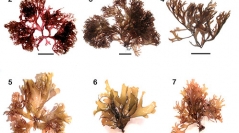

 Cryptogamie, Algologie
31 (4) - Pages 387-401
Cryptogamie, Algologie
31 (4) - Pages 387-401The red algal family Gracilariaceae is commercially valuable due to its use in biotechnology and microbiology research as a phycocolloid agar. Gracilaria species are difficult to identify by morphological features alone, and the taxonomy of the gracilarioids occurring in Korea is uncertain. We tested the effectiveness of DNA barcoding in the identification and discovery of Gracilariaceae species in Korea. Our analysis of cytochrome c oxidase 1 (COI) sequences from 75 specimens yielded a total of five species: the four Gracilaria and one Gracilariopsis species were Gracilaria incurvata, G. parvispora, G. textorii, G. vermiculophylla, and Gracilariopsis chorda. Intraspecific uncorrected divergences ranged between 0 and 0.9, and interspecific divergences were 9.2-16.1. These findings prompted further taxonomic studies on the Gracilariaceae to better understand species diversity, with more extensive specimen sampling from the known distributional areas in the Asian-Pacific region. The results indicated the validity of mtDNA COI sequence data in identifying species via marine biomonitoring of family members and also in understanding the species boundaries of this group. Our study demonstrates that DNA barcoding can provide an efficient method for species-level identifications and contribute powerfully to taxonomic and biodiversity research.
Also available on Connect.barcodeoflife